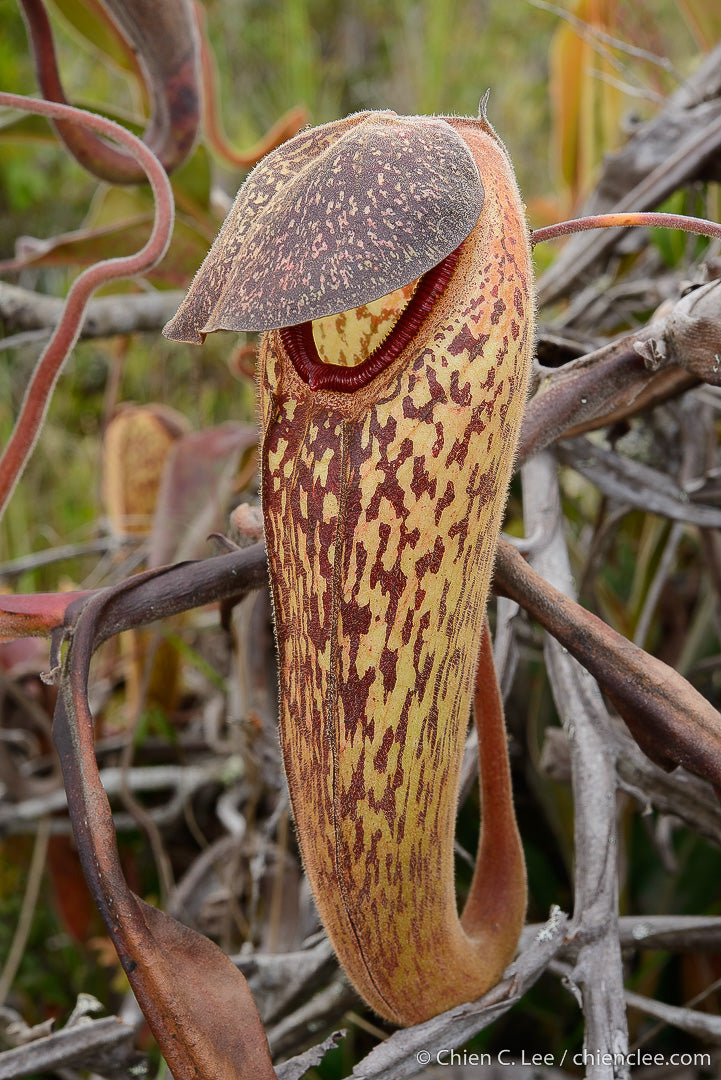

Nepenthes klossii occupies a place near and dear to my heart for many reasons. First off, the obvious; Nepenthes klossi produces some of the most interesting traps in the genus. The pitchers are large, lobster pot style traps with a vertical opening reminiscent of Nepenthes aristolochioides but much bigger.
The species is endemic to the extremely remote Wissel Lakes area of Papua, Indonesia. It wasn't known to the Western world that the area was inhabited until the late 1930's. Currently, the only access is either by missionary plane or an 18 hour ride via 4WD from Nabire through treacherous terrain. It's possible that klossii has a wider distribution than is currently documented; however, the area is so remote much of it has simply not been well botanized.

In its habitat, Nepenthes klossii seems to grow as a scrambler amongst brush in moist areas. The Wissell Lakes is a highland region sitting at 1800 meters in elevation. I'm not sure of the specific weather patterns of the klossi habitat because the local topography in Papua can be so extreme that weather patterns can be completely different even in neighboring valleys or mountains. In from my travels throughout similar elevations in Papua, it does seem that there is less frequent rainfall and a more prolonged dry season than other places you'd find highland Nepenthes. Nepenthes maxima grows sympatrically with klossii as evidenced by some hybrids that have been produced from wild collected seed. I find them fantastic and fast growing!



In cultivation, I’ve found Nepenthes klossii to be a moderately slow grower. Even though it's from 1800 meters elevation, my plants grow faster when given intermediate conditions. Some growers even have it growing in their lowland houses where it seems to do well for them. Although, given the choice between my highland or lowland room, I'd place them with the highlanders. I have found that Nepenthes klossii is particularly prone to fungal issues on its leaves so I would recommend to grow it where the leaves can dry out between mistings. If that's not an option (like a highland greenhouse in Texas that relies on misters for daytime evaporative cooling in summer) then I recommend routine spraying with a systemic fungicide such as Thiophanate-methyl (trade name Cleary 3336 in the USA). Though it grows fine in my standard sphagnum mix, it has been reported that Nepenthes klossii doesn't grow primarily in sphagnum moss in situ. I've also seen plants grown in rinsed coconut where they seemed happy.



Nepenthes klossii has always been extremely rare in cultivation and there are certainly reasons. The Wissel Lakes region of Papua is quite untenable for travelers. Unfortunately, this is an area next to the world’s largest gold mining operation run by Freeport McMoRan. I come from generations of miners in towns like Morenci, Arizona where copper is king. Freeport owns those mines too and even in Arizona it’s always been evident that Freeport (and its predecessors) pushes the limits of what they can get away with with regards to exploitation of the environment and human rights. In Papua, I can hardly imagine the depths they go but I’ve been told that the locals in this area are treated somewhere between humans and animals by government and corporate officials. This all culminates into an extremely tense socio-political situation that makes visitation by any outsiders extremely dangerous.
Recently, a trip was made by some of my friends who are Nepenthes researchers. The group was attacked with spears by some of the locals and then held captive for a day while a mob of hundreds of villagers with machetes stood outside the building where they were held. Luckily, through some intense negotiations, they were able to escape unharmed.
Due to the tense situation, further research or additional seed collection in the region is unlikely (or at least extremely difficult and dangerous). Borneo Exotics is the only nursery to have produced Nepenthes klossii commercially but nearly lost all their cultures due to a lab accident. At the time where stocks were at their lowest, I visited Sri Lanka and provided my knowledge of sterilization and contamination mitigation techniques based on my laboratory trials. Though the real work was done by the skilled lab staff at Borneo Exotics, I’m happy to have been able to provide a modicum of assistance and support with chemical formulations that enabled the elimination of contamination which saved the only sustainable source of klossii in cultivation.
Last year, we imported a large number of different clones from Borneo Exotics and have now grown them out to sufficient size that we are certain that all the ones we have for sale are true klossii. We have noticed some variation between clones but think they all fall within what we've seen in the confirmed klossii we have already grown to larger sizes. Since these clones are genetically different we're hoping that there will be a mix of males and females in the batch for future line breeding efforts. In order to confirm whether or not each clone is true, we are retaining larger plants of all clones. Check the photos and details of the offers on our klossii sales pages below:
Nepenthes klossii, BE-3452 (confirmed BE clone)

Drew, are those intermediate pitchers on the hybrid? I’m curious if the uppers will retain the same color, or will they turn green like most maximas. Aside from the shape, I think the colorful uppers of N. klossii are an important trait for hybridizing; it’s not always easy to keep the uppers from “greening out” in breeding.